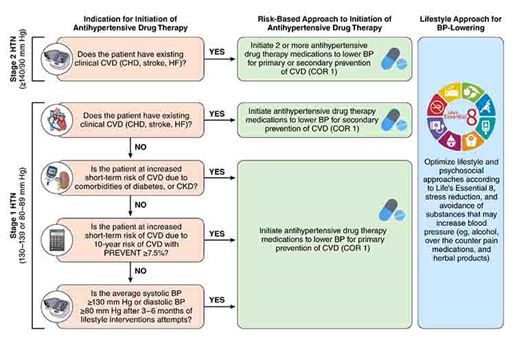Use of Risk Assessment to Guide Decision-Making for Blood Pressure Management in the Primary Prevention of Cardiovascular Disease
Published: August 28, 2025

- Risk-based assessment plays a central role in hypertension management by aligning treatment decisions with overall cardiovascular disease (CVD) risk and blood pressure levels.
- The 2025 ACC/AHA/Multi-Society Guideline for the Prevention, Detection, Evaluation, and Management of High Blood Pressure in Adults recommends the American Heart Association Predicting Risk of Cardiovascular Disease Events (PREVENT™) equations to estimate 10-year risk of total CVD (PREVENT-CVD) and establishes the evidence-based treatment threshold of 10-year risk of total CVD of 7.5% or higher for initiation of drug therapy in patients with Stage 1 hypertension (130–139/80–89 mm Hg).
- This AHA/ACC scientific statement outlines the rationale for the guideline’s framework for risk-based assessment, including the adoption of the PREVENT-CVD equations and the 7.5% treatment threshold, and provides practical guidance to support clinical implementation and shared decision-making.
Read the full Statement in Circulation
Read the full Statement in Hypertension
Using the PREVENT Equations for Managing High Blood Pressure
Writing Group Chair Sadiya S. Khan, MD, MSc, FAHA and Vice Chair Donald M. Lloyd-Jones, MD, ScM, FAHA explain how the PREVENT equations for assessing cardiovascular risk were incorporated into the 2025 High Blood Pressure Guideline recommendations to more accurately identify which patients are likely to benefit from treatment, when to initiate treatment, and what blood pressure targets to use for the primary prevention of cardiovascular disease.
Related Resources
- Hub - Use of Risk Assessment to Guide Decision-Making for Blood Pressure Management in the Primary Prevention of Cardiovascular Disease Hypertension
- Hub - Use of Risk Assessment to Guide Decision-Making for Blood Pressure Management in the Primary Prevention of Cardiovascular Disease Circulation
- American Heart Association PREVENT™ Risk Calculator
- Recent Guidelines and Statements